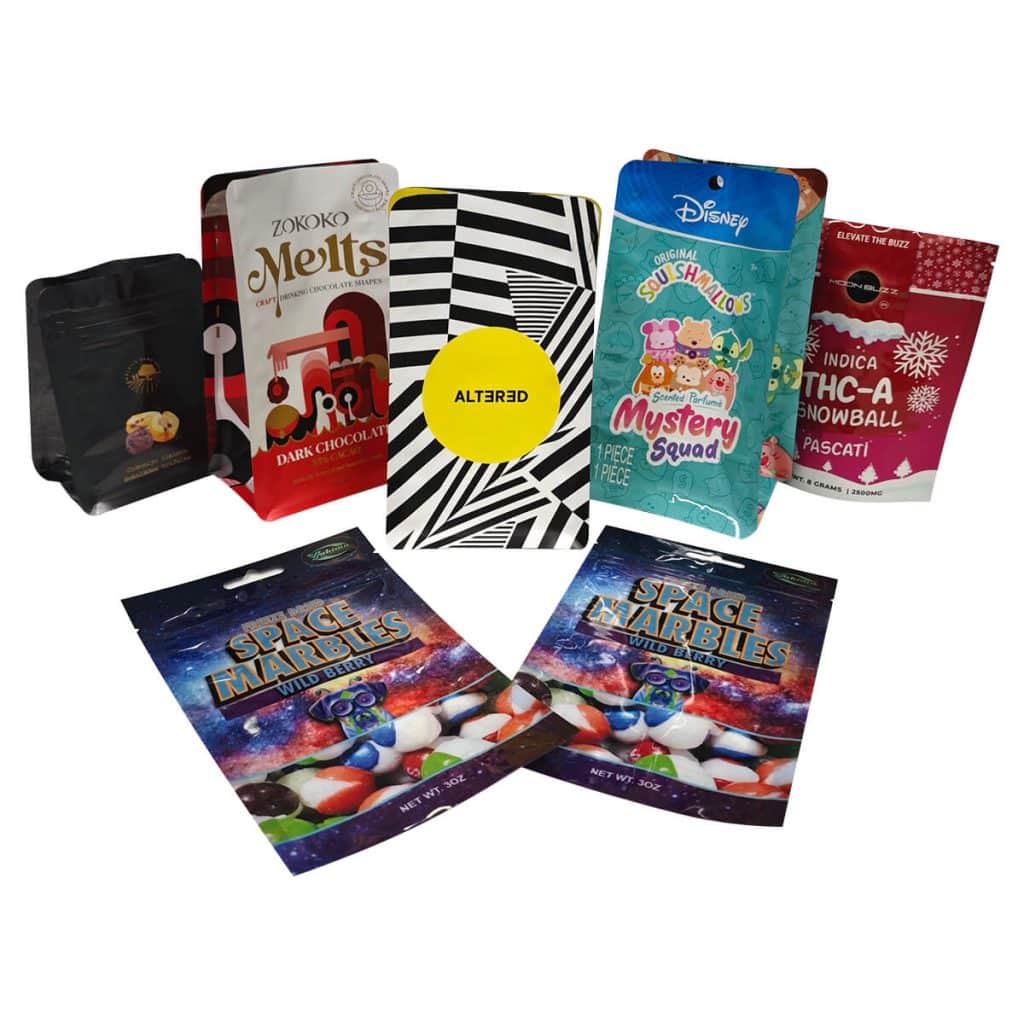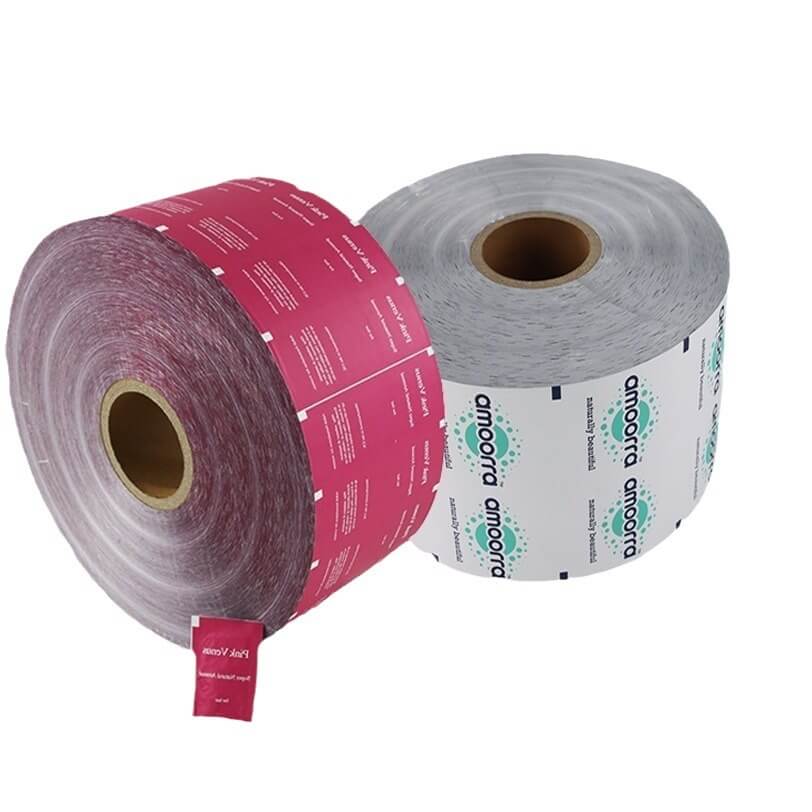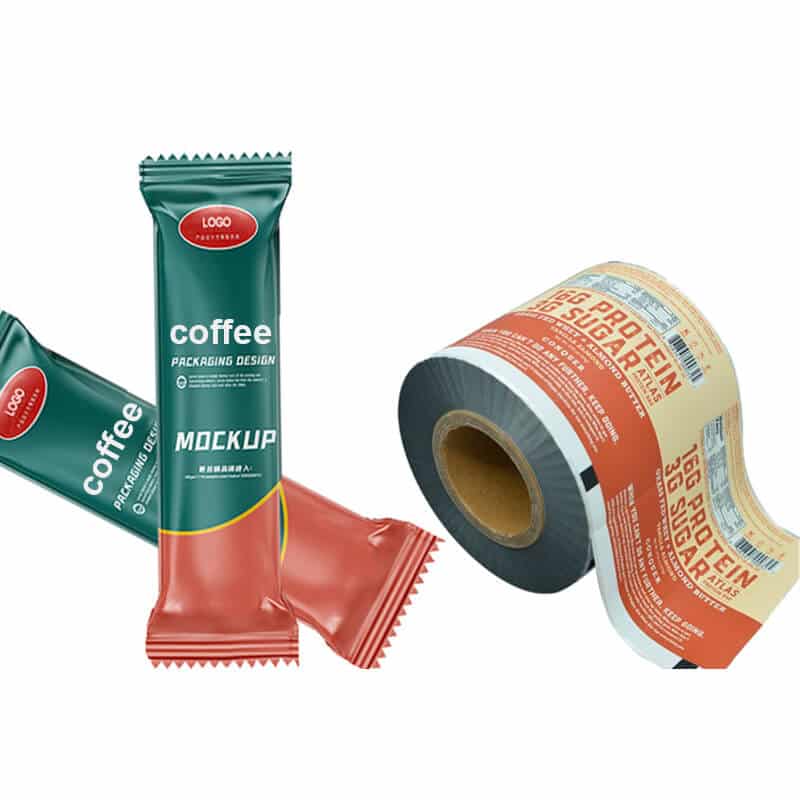Plastic packaging material
Plastic is one of the most common packaging materials; it is printed as a packaging bag, has the advantages of being light and transparent, moisture-proof and oxygen-resistant, good airtightness, toughness and folding resistance, smooth surface, can protect the goods, and can reproduce the shape and color of the goods.
Different plastic compositions, functions, and roles are also different. Today, we introduce some common packaging materials, advantages, disadvantages, etc.
The leading plastics commonly used in packaging are polyethylene and polypropylene: polystyrene, polyvinyl chloride, polyurethane, and console resin.
Polyethylene (PE)
Polyethylene is a polymer of ethylene and is a thermoplastic; according to its industrial production method, there is a high-pressure, medium-pressure, and low-pressure polymerization method.With different production methods, its molecular structure also varies greatly, and product performance also varies with the molecular structure.
Polyethylene is a milky white waxy solid, lighter than water, softer, has better water resistance, low-temperature resistance, tasteless, non-toxic, poor heat resistance, poor air tightness of the film, and sensitive to ultraviolet light. Easy to oxidation, aging, heat shrinkage changes, printing performance is poor, according to its density.
It can be divided into high-density, medium-density, low-density polyethylene, and linear low-density polyethylene.
Polypropylene (PP)
Polypropylene is obtained by using propylene, a by-product of petroleum refining; after refining propylene monomer, the polymerization reaction is catalyzed by a catalyst and then separated from the polymer.
Molecular weight is 100 ~ 500,000; density is minimal, is the most miniature known plastic; non-toxic, tasteless, high transparency, mechanical properties, surface strength, anti-friction, chemical corrosion resistance, moisture resistance are very good; above room temperature impact resistance value is large, but low-temperature impact resistance value is small; it is easy to carry static electricity, printing performance is not good. Polypropylene has a wide range of raw material sources, low price, and comprehensive performance adaptability.
It is widely used in the food industry. Most used in the manufacture of film, composite film, with good transparency and surface gloss, can withstand a temperature of 120 degrees; can be made into boxes, blow molding into plastic bottles, add some fillers can be made into certain machine parts, etc.
Polystyrene (PS)
Polystyrene is made of ethylene and benzene in an anhydrous aluminum trioxide catalyst, by the chemical reaction to generate ethylbenzene and catalytic dehydrogenation of styrene. Styrene monomer in the right amount of initiator (benzoyl peroxide) and dispersant (polyvinyl alcohol) in a water suspension heated polymerization of polystyrene.
Polystyrene is a colorless, transparent, non-ductile thermoplastic; non-toxic, tasteless, odorless, good coloring, moisture permeability greater than polyethylene, deficient moisture absorption, dimensional stability, good gloss; good processing properties, low cost; mechanical properties with the increase in molecular weight and improve; low heat resistance, can not be used in boiling water; low-temperature resistance can withstand -40 ℃ low temperature; good indoor aging resistance; good resistance to alcohol organic solvents, mineral oil, acid, alkaline performance is also very good.
Polystyrene, due to superior performance, low price, and wide application, can be made into a film, and containers, widely used in the food industry; a shrinkage rate of up to 60 ~ 70%, is a good material for the production of shrink packaging has good insulation properties, can make a variety of telecommunications parts; can also make a variety of machine parts, toys, daily necessities, etc.; in polystyrene with a foaming agent, can be manufactured foam, is an excellent cushioning packaging material.
Polyvinyl chloride (PVC)
Polyoxyethylene is vinyl chloride by the role of the primer, suspension polymerization, or emulsion polymerization and generates polyvinyl chloride. It is light brown, transparent, has good toughness, a density of 1.4g / cm; good chemical stability, not easy to be acid, alkali corrosion; airtightness, water resistance, heat sealing performance, good printability, less energy consumption, cheap production; mechanical strength, wear resistance, pressure resistance is better than polyethylene and polypropylene.
The main disadvantage is that the thermal stability is poor, easy to decompose by heat, emitting hydrogen chloride gas. Due to the different varieties and quantities of additives, such as plasticizers and stabilizers, PVC can be made into other products, complex products, such as rigid pipes, construction materials, etc.; artificial leather, wire, and cable insulation, plastic flooring, etc. Its most important role in packaging is to make films divided into soft, rigid, and shrink films. The soft film has a smooth texture and good heat sealability, suitable for high-frequency sealing tables; tensile strength is minimal, tear strength is very high; poor sliding and processing performance is also flawed.
Hard film tensile strength and tear strength are more significant, hard texture, elongation is slight; moisture permeability is small, sound gas barrier, sliding is good; printing adaptability is good, but to choose the appropriate ink solvent; temperature resistance is poor, low temperature becomes brittle. Shrink film has good transparency and negligible air permeability, produces shrinkage when heated, has a wide range of shrinkage temperatures and significant shrinkage rate, and is a good heat shrink packaging material. According to its different production processes, it can be divided into dry stretches. Tube stretching and longitudinal, horizontal one-way stretching and other varieties.
Polyester (PET)
Polyester is the condensation product of terephthalic acid and ethylene glycol. Compared with other plastics, polyester has a set of excellent barriers, such as carbon dioxide, oxygen, water, and fragrance can be tremendous barriers; with excellent mechanical properties, high strength, compressive and impact resistance; chemical stability, acid, alkali corrosion; high transparency, gloss, optical properties; non-toxic, tasteless, in line with food hygiene standards; its structure has ester groups, so good printing performance. Polyester is a unique and versatile packaging material. It can be manufactured film, made into bottles, cans, cups and other packaging containers, can also be dual-use can be baked tray.
phenolic plastic (PF)
Phenolic resin is made of phenols (main phenol) and aldehydes (main formaldehyde) condensation. Depending on whether the catalyst is acidic or basic, the ratio of phenol to formaldehyde is different. Thermoplastic resins or thermosetting resins can be obtained. The two can be converted into each other under suitable conditions. In practice, thermosetting resins are mainly used. Phenolic resin has good mechanical strength; thermal strength is also excellent; moisture resistance, good corrosion resistance, easy processing, and low price.
After adding different fillers and curing agents to phenolic resins, various phenolic plastics can be made. A variety of flake filler into the thermosetting wax, after lamination, can be a variety of properties of the laminate; adding foam can be made of phenolic foam; phenolic plastics for packaging is made of phenolic resin mixed with fillers, curing agents, coloring agents, such as molding powder, and then molded into caps, machine parts, daily necessities, and some packaging containers.
Phenolic plastic products have good chemical stability, excellent heat resistance; high mechanical strength, wear resistance, not easy to deformation, but poor elasticity; good electrical insulation; monotonous color, mostly raspy red or black. As its primary raw materials are phenol and formaldehyde, with a certain degree of toxicity, it is unsuitable for food packaging materials.
Polyamide (PA)
Polyamide is commonly known as “nylon,” available dibasic acid and binary through the condensation reaction and obtained. Polyamide is non-toxic, colorless, and transparent; good abrasion resistance. Strong impact toughness, excellent mechanical properties; good light resistance, light is not easy to aging; good oil resistance, good chemical stability, but not resistant to alcohols, formic acid, and phenol; good airtightness; adaptability to temperature, can be used in the range of -40 ~ 100 degrees; good printability and decorative; moisture absorption.
Polyamide is widely used to make bearings, gears, pump leaves, auto parts, and so on. Its application in packaging is mainly flexible packaging, made of film for food packaging can also be manufactured packing tape and rope; its sturdiness is better than polypropylene packing tape.
Urea-formaldehyde plastic (UF)
Urea-formaldehyde plastic, commonly known as “electric jade,” is made of urea and formaldehyde as raw materials, condensation reaction, and urea-formaldehyde resin, and then added fillers, coloring agents, lubricants, plasticizers, and other processing into pressure plastic powder (electric jade powder), and then heated, molded and made products.
It has a hard surface, a specific mechanical strength, not easy to deformation, but brittle; odorless, tasteless, strong coloring power, bright colors, resembling jade; good heat resistance, not easy to burn; acid resistance, alkali resistance, poor water resistance, water absorption, good electrical insulation. Urea-formaldehyde plastic can be made into a variety of products, such as daily necessities, electrical components, etc. The package can be made into beautiful boxes, packaging trays, bottle caps, etc.; because formaldehyde has a certain degree of toxicity, it should not be used for food packaging. Adding foaming agent to urea-formaldehyde resin and making it foaming by mechanical method, urea-formaldehyde foam can be obtained. It is light, inexpensive, has good heat preservation and corrosion resistance, and is a widely used buffer packaging material.
Polylactic acid (PLA)
Good mechanical and physical properties. PLA is suitable for various processing methods, easy to process, and widely used. It also has good tensile strength and flexibility; multiple standard processing methods can produce PLA.
Good biocompatibility and degradability.
PLA also possesses good gloss and transparency, comparable to films made from polystyrene, which other biodegradable products cannot provide.
Polylactic acid (PLA) film has good breathability, oxygen and carbon dioxide permeability, and odor barrier properties. PLA is the only biodegradable plastic with excellent anti-bacterial and anti-mold properties.
When incinerated, PLA is half the cost of burning conventional plastics such as polyethylene, and incineration of PLA releases no toxic gases such as nitrides and sulfides.
Miamine plastic (ME)
Miami and urea-formaldehyde plastics belong to the same amino plastic. It is melamine and formaldehyde by condensation reaction and resin as the main component, adding fillers, lubricants, coloring agents, hardeners, etc., by hot pressing, also belongs to the thermosetting plastic.
Miami are non-toxic, odorless, tasteless, good hygiene performance; mechanical strength, good surface hardness, not easy to deformation, smooth surface, feel like porcelain; impact resistance, strong anti-pollution ability; good chemical stability. Miami plastic can be used to make packaging containers, including food packaging in various colors.
Polyvinyl alcohol (PVA)
Polyvinyl alcohol is the hydrolysis product of polyvinyl acetate. It is transparent, non-toxic, tasteless, has excellent helium resistance 3, water resistance, and oil resistance; good chemical stability; good printability, non-static; good mechanical properties.
Polyvinyl alcohol in packaging more use of its film, can be used for food packaging, to prevent oxidation of food discoloration, taste, and deterioration, to maintain the freshness of food has a significant effect; can also be packaged other products, such as chemical products.
Polycarbonate (PC)
Polycarbonate is a general term for resins containing carbonate structure in the molecular chain, usually referring to the polycarbonate bisphenol-A type. It is colorless and transparent, has good gloss, has excellent heat and cold resistance, can be used for pressurized sterilization, and has high mechanical strength. Can be juxtaposed with polyester and nylon; excellent impact toughness, the product is not easy to rupture by impact; water absorption, moisture absorption, permeability is small; good chemical resistance can prevent ultraviolet light through the non-toxic, odorless, tasteless; molding performance is good, with the general molding method can be. The precision of formed products is very high. Old heat sealing performance is poor.
Polycarbonate is an all-around performance of excellent engineering plastics, can be made into a variety of gears, machine parts, etc.; can be made of film, used to package food and other items, need to be sealed, made of composite film to improve the heat sealing properties; can also be made into a variety of packaging containers.
Polyvinylidene chloride (PVDC)
Polyvinylidene chloride is a homopolymer of partial oxyethylene. It is non-toxic, odorless, transparent, and has mechanical strength. Good toughness; oil and organic solvents; heat shrinkage and self-adhesive, film can be quickly bonded; airtightness, moisture resistance is excellent. However, it has poor mechanical processability, poor thermal stability, is not accessible to heat seal, and is easy to decompose when subjected to ultraviolet light.
The main application of polyvinylidene chloride in packaging is the production of food packaging film, which can be used as sealed packaging and effectively prevent food from absorbing moisture. It can also be used as packaging for sterilized food because it can be heated and fixed and used as packaging material for daily household use.
Polyurethane (PVP)
Polyurethane is also known as polyurethane, which is made by the reaction of isocyanate and hydroxyl compounds. The main characteristics of polyurethane are good abrasion resistance, excellent low-temperature resistance, oil resistance, and chemical corrosion resistance. Polyurethane is mainly processed into foam; changing raw materials and ratios can be obtained from soft and rigid foam. Gentle products have good toughness, good elasticity, and oil resistance.
They are the main varieties of polyurethane foam, widely used in packaging to make cushioning materials such as padding. Frozen products are heat-resistant, cold-resistant, adiabatic, excellent shockproof, and commonly used in the packaging of precision instruments and meters. The production of polyurethane foam is simple. Easy to operate, low cost, good shockproof performance, can be made at room temperature, primarily through the field foam, to bring great convenience to the packaging.
Aluminized film
Aluminized film has the characteristics of both plastic film and metal. The role of film surface aluminizing is to shade anti-ultraviolet radiation, extend the contents’ shelf life and improve the film’s brightness, to a certain extent instead of aluminum foil, but also inexpensive, beautiful, and better barrier properties. Therefore, the aluminized film is widely used in composite packaging, mainly in cookies and other dry, puffed food packaging, pharmaceuticals, and the outer packaging of cosmetics.
PE, PP, PO, OPP, PVC, PETPETG, GAG, POM, and other materials, PE, PP, and POM, are all non-toxic materials dedicated to food; PET, PETGGAG materials are environmentally friendly materials generally through SGS.
Choose the proper packaging plastic for your product.
Understanding some types of plastics and their characteristics and uses can help you choose the right kind of plastic. We are a professional packaging manufacturer.
If you still don’t know how to choose the packaging material, tell us the product you need to package, and we will have our technical staff give you professional advice.
Our mission has always been to provide customized services for packaging bags and help our customers enhance their products’ brand awareness. If you have any questions about plastic packaging, don’t hesitate to get in touch with us.






